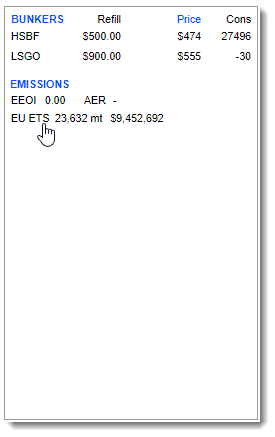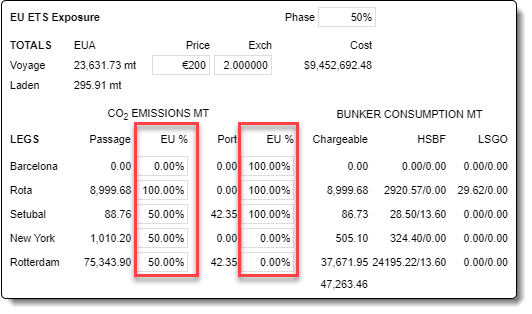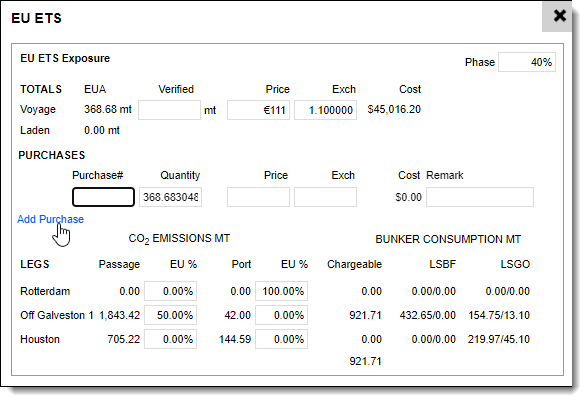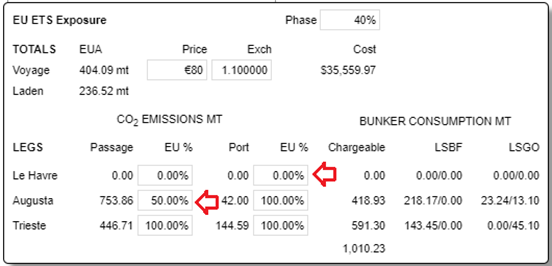VMS - EU ETS Solutions Overview
The following document is designed to aid VMS customers in managing EU ETS regulatory changes. It includes information on what functionality is already available, what is on the roadmap, and recommendations for frequently asked questions.
Please feel free to reach out through our Help Center for further information or assistance.
Released Functionality (Available as of 2023 Q3)
EUA Calculation
VMS estimates the EUA requirements by voyage. The calculated value is applied to the voyage TCE automatically.
The EU regulations require that the EU% is determined by journeys between cargo-active ports, ignoring port calls for other purposes. This means the EU% is determined by journeys between the “L” and “D” legs. Any “I” or “C” legs inherit from the containing journey.
Within a journey, EU to EU is at 100%. EU to/from non-EU is 50%. This applies to both passages and ports.
At the end of a journey, EU is 100%, and non-EU is 50%. This applies to ports.
The phase (40%, 70% or 100%) is set at the voyage level, basis the voyage end date. (E.g. if the voyage ends in 2024, then the phase is 40%.)
Access the full calculation by clicking on the EU ETS quantity or cost in the Emissions section of the voyage main page.

Price and Exchange Rate
The calculator lets you enter a Euro price and exchange rate for the EUA requirements.
These values are set by default in a new estimate based on the Bunker Prices and Currency Exchange Rates in Company Settings.
If you don’t have Currency Exchange Rates in Company Settings, please get in touch with us and ask for Multi-currency capability, or you can just set the Exchange Rate for each voyage.
Overwrite capabilities
You can edit any phase, price and exchange rate by voyage and EU percentage by leg for fine-tuning or handling any unusual situations.

Expense and TCE
“ETS” as Expense type (and Revenue Type)
Automatic generation of an Expense item when an ETS cost is calculated.
Entering verified EUA quantity to overwrite the calculated value.
Purchases
Enter EUA purchases to allocate to the voyage

Reporting
New EUA purchases data source
EUA amount and cost by Voyage in Voyage Extended data source
The Voyage Report will include EUAs
Small Vessels
Vessels below 5,000 GT are not subject to EU ETS. We have released a feature in the vessel register to exclude a vessel from EU ETS for all voyages.
Upcoming Features (To Be Released)
Time Charter
The EU ETS calculations are inaccessible because LTTC (TC Out) voyages do not include a Bunkers panel. We will make them accessible during the voyages.
EUA and Year-End Best Practices
The EUA calculation, by default, calculates with only one phase per voyage. 40% for 2024, 70% for 2025, and 100% thereafter. However, using the overwrite capabilities, it is easy to estimate the total EUA requirement for a voyage that spans two years. Below are two alternatives depending on the rigour of precision needed.
1. Change Phase for a rough estimate.
The phase for 2023 is 0%, and for 2024 is 40%, so if a voyage has roughly three-quarters of the gross days in 2023, enter 10% as the phase. For half the voyage in each year, enter 20%, and for a quarter in 2023, enter 30%.
2. Change EU percentage for a good estimate
The year change happens only in one passage or port stay. Go into the calculator and prorate the percentage field for that passage or port. Set prior legs to 0% and leave subsequent legs untouched. To be even more precise, you can duplicate the year-end leg and set the departure to exactly 00:00 on Jan 1 of the new year. This leg then attracts 0% EU (no need to prorate).
Example
A voyage entirely in the EU has 4 days in 2023 out of a total voyage of 14.4 days. This is roughly three-quarters in 2024. The passage from Le Havre to Augusta is about eight days of which four are in 2023 or roughly 50% in each year.

Either change the phase to 30%, representing one quarter at 0% and three quarters at 40%.

Or change the Augusta passage to 50% and anything prior to 0%.

Both estimates produce similar results.
Frequently Asked Questions
The below concepts are frequently asked in relation to EU ETS solutions.
Leveraging VMS for EUA Revenue and Invoicing
Given how the markets are currently handling EUA revenues, no additional feature is built for this purpose in VMS. Use the new “ETS” revenue type (coming soon) and enter the number of EUAs and price in US$ (or in EUR if you have the multi-currency feature enabled).
During 2024 we will keep an eye on the markets and if a calculable revenue amount emerges, we will seek to include this in the EU ETS calculator.
To invoice EUAs, simply add the ETS Revenue item and invoice it in the normal way.
What is the default phase and what options are there around year-break mid-voyage?
The default phase is set basis the end date of the voyage. Phase is not subdivided within a voyage. See “EUA and year-end” for methods to manage voyages that span years.
How should we handle Revenue line items?
For revenue and invoicing, just add a line item under Revenue with type ETS. As the EUA recoverable from the charterer differs from the EUA applicable to the whole voyage, the EU ETS calculator has no automated interface with revenue.
How can we handle EUA Transfer of Allowance?
VMS allows for income and cost on EUA. It does not cover the cases where Allowances are transferred between parties without any financial transactions. It could be simulated by including EUAs with zero price, but no purpose-built system exists for such transactions.
Is there MRV-related functionality?
VMS does not cover the precise requirements needed for MRV reporting.
How does VMS calculate EUA for EU and EU Outermost Regions?
Journeys between EU countries and EU outermost regions, or EU Overseas Countries and Territories, are subject to specific EU regulations. If you are undertaking such journeys, please check carefully with EU regulations and use the VMS overwrite capabilities as needed.
For EUA calculation purposes, VMS treats the following territories as EU: Azores, Madeira, Guadeloupe, French Guyana, Martinique, Mayotte, Saint Martin, and Reunion.
What about exemptions for Biofuels?
VMS does not cover any specific exemptions for Biofuels. Please use the overwrite capabilities to handle these.
